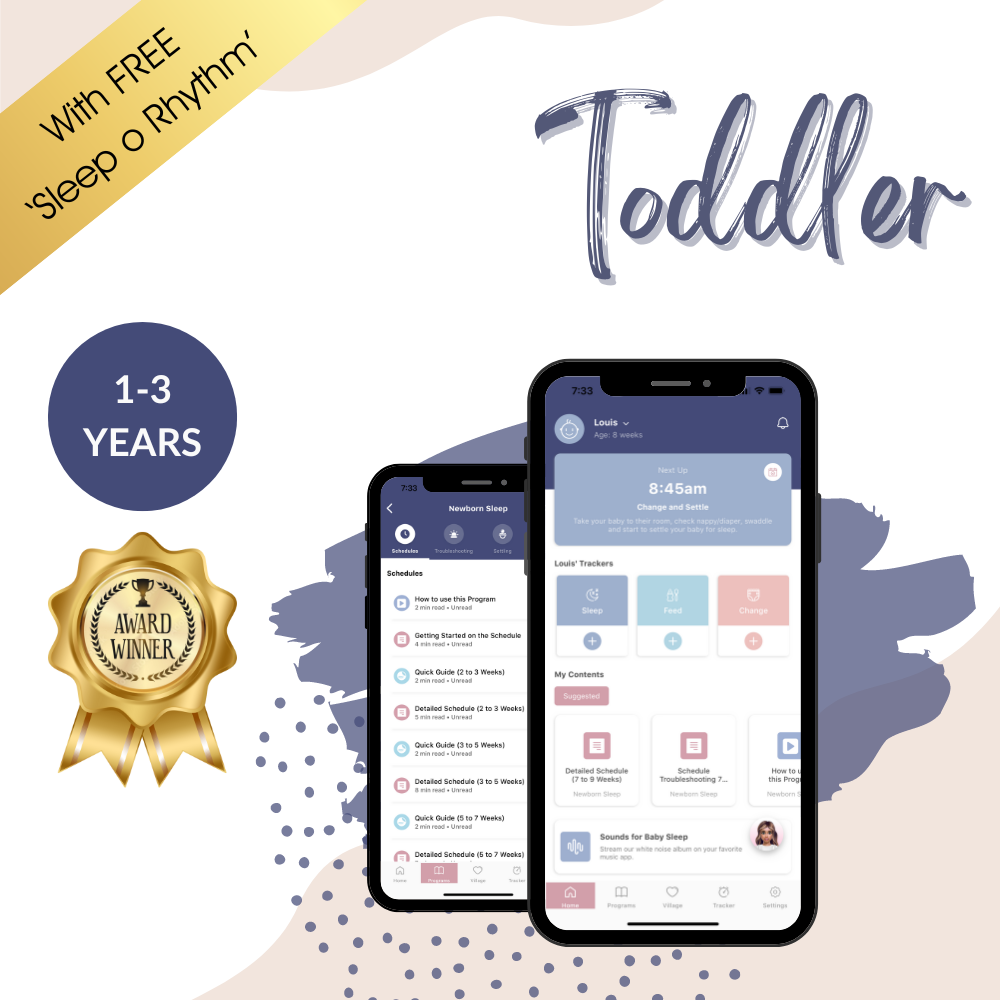
How to Get Your Baby to Sleep: Gentle, Proven Tips by Age
Good sleep for your baby or toddler doesn't have to be complicated. Nor does it have to involve crying or traditional "sleep training". Sometimes, improving your child's sleep is as simple as tweaking a baby's awake windows, or making their room darker.
We are all about this "holistic" look at your baby's sleep because we understand how all the different elements line up to help your little one become an expert sleeper. Move over sleep training; ours is the new way of approaching baby and toddler sleep and it's incredibly successful, not to mention gentle.
So here we are - sharing our secrets with you! What follows are our 7 proven steps to better sleep:
1. Sleep Environment
2. Awake Times
3. Wind-Down Time
4. Settling
5. Nap Length
6. Milk/Solids Intake
7. Overnight Expectations
These are the most important factors that will affect a baby or toddler's ability to settle easily and sleep well so read on to find out more!
Feeling confused about your baby's sleep needs?
Let our sleep experts help you every step of the way. Together we can solve your little one's sleep challenges
Get our Sleep Programs
Step 1: Sleep Environment
Making sure your little one's sleeping space is really sleep-promoting is an easy step in the right direction. Babies love white noise as it helps them link sleep cycles together and also blocks out household noises that might wake a sleeping baby. Make sure there is nothing stimulating in their environment to distract them from sleeping such as a nightlight or musical mobile.
A dark room becomes important beyond 8 weeks old because the dark stimulates the release of melatonin - a hormone that helps us sleep. Use of a swaddle or baby sleep sack helps create a cosy, warm sleeping space for your baby.
Actions:
- Make your baby's room as dark as you can (perhaps invest in some blackout blinds or just put an extra blanket or sheet over the existing curtains).
- Use a swaddle for younger babies - until around 5 months old or until they are rolling, whichever comes first.
- Turn on and turn up the white noise (it should be as loud as a shower for all naps and overnight).
Step 2: Awake Times
Having the right awake times for your baby is crucial to your baby settling easily and napping well. An awake time simply means the amount of time your little one is awake for (including feeds) between naps. A baby who isn't awake long enough between naps might fight going to sleep or only nap in short stints, simply because they're not tired enough. A baby who is awake for too long between naps will also fight sleep because they are overtired.
Awake times are constantly changing as your baby grows and develops - so the awake time for a 2 week old baby will be vastly different to the awake time of an 8 week old baby. Depending on the age of your baby, their awake times throughout the day will also change. For example, a 7 month old baby will have the same amount of awake time between naps in the morning, but then a longer awake period in the afternoon/evening.
Say goodbye to sleepless nights.
Join over 800,000 families worldwide who are enjoying excellent sleep with our Sleep Programs, created by experts in the field of pediatric sleep.
Get our Sleep Programs
Action:
- If your baby is not settling well, look at the length of their awake time and possibly extend or reduce it. You can experiment with this every few days until you get it right, or take away the guesswork by following the age-specific sleep schedules in our Little Ones App.
Step 3: Wind-Down Time
Babies can get overstimulated very easily, so some wind-down time before a nap is important to let your baby get in the zone for sleep. This, as part of a nap routine or bedtime routine, will also signal to your baby that sleep is approaching and act as a sleep cue in their day. For winding down, you could cuddle and sing to your baby, read a story, talk quietly to your baby while cuddling them in a dimly lit room.
Action:
- Create and implement a wind-down routine, a longer one for bedtime in the evening and a shorter one for before naps.
Step 4: Settling
A baby's ability to settle to sleep is dependant on two main factors - that they are perfectly ready for sleep (by getting their awake times right) and also their age. Before the 4 month regression hits, settling your baby totally to sleep if needed is absolutely fine! It is a good idea to settle them to sleep in their bed, using our side-settling method for example, so they learn that their bed is where they fall asleep when tired.
For older babies, the time can come when your baby is ready to learn the important skill of falling asleep independently. This will mean they're able to drift off unassisted at the start of a nap and then resettle themselves between sleep cycles during the nap and overnight. If a baby is relying heavily on being actively settled to sleep, they will need this settling to happen every time they naturally rouse between sleep cycles in the day and overnight.
Actions:
- If your baby is under 4 months and difficult to settle, have a look at tweaking their sleep environment and awake time.
- If your baby is over 4 months, give some thought to the way they are used to falling asleep. If they're relying on you to actively "put" them to sleep, you can start to work on gently guiding them to falling asleep independently for longer naps and more consolidated night time sleep.
If you need help guiding your baby to independent sleep, we've got nine gradual, age-appropriate methods to choose from in our Little Ones App. Our certified sleep consultants are also available day and night to support you every step of the way.
STEP 5: Nap Length
Some babies need a hand regulating their nap lengths so that they nap for the perfect amount, at the optimum times of the day, to lead to easy settling and good night time sleep. Some babies love to sleep in the day and are then up all night because they've had too much day sleep and genuinely aren't tired enough for a deeper sleep overnight. Sounds crazy but it's true!
It is most restorative for babies and toddlers to have a couple of hours sleep across the middle of the day, when there is a natural dip in energy levels for all humans and our biological sleep window is open. If a baby naps for too long in their morning nap they won't be tired enough to have a longer nap at lunchtime and this can end up leading to a build up of over tiredness throughout the day.
Having more control of a baby's nap lengths means you can set them up for excellent nap habits that are sustainable for years to come - namely establishing and maintaining that long lunchtime sleep which your child will keep until they're around 3 years old.
Actions:
- Try waking your baby from their naps if you think they're oversleeping in the day (and wanting to party all night).
- Aim for a shorter morning sleep, a long lunchtime nap and, if needed, a small late afternoon nap.
Naps can be tough but don't worry, we've got you! Discover the best nap times and lengths for your baby's age in our Little Ones App.
Step 6: Milk/Solids Intake
The affect milk and solids has on sleep is quite dramatic. A hungry baby won't settle or sleep. Likewise, the types of solid food offered at certain times can affect a baby's sleep too. We would always recommend feeding your baby when they wake from a nap, so they're awake and restored enough to take a decent feed.
Feeding a baby right before they go to sleep can mean they're too tired to take a big feed and might only have a short nap, waking hungry. It can also mean a feed-to-sleep association is developed, which can begin to affect a baby's nap length and night-time sleep eventually as well.
For solid food, we recommend going easy on protein at the dinner meal initially as, for some babies, it can cause discomfort and night waking due to their digestive system struggling to digest the protein overnight. For babies between 6-10 months, offering protein at the lunch meal is a great choice.
Actions:
- Try feeding your baby when they wake from a nap.
- Offer solids at lunchtime first and be careful with protein at dinner until your little one is a bit older.
Let's get your little one's sleep sorted ASAP!Our award-winning Sleep Programs will solve your baby's sleep challenges in no time.
Get our Sleep Programs
Step 7: Overnight Expectations
A baby's night time sleep is dependant on so many factors lining up: the amount of daytime sleep they've had, the timings of those naps, milk and solids quantity and times, their sleep environment, settling ability...
Good night sleep is definitely not just about "sleep training" and don't listen to anyone who tells you otherwise. Babies are certainly capable of sleeping for good lengths overnight from quite early on, if everything is lined up right, but it is still quite normal for a baby to be waking for milk in the night until they're well established on solids.
If however, you feel your baby's night waking is excessive, you could look at the other factors in this article and try and make some changes there, rather than just assuming hunger every time your baby wakes. It might be as simple as tweaking their nap structure to get better overnight sleep!
Actions:
- Have realistic expectations about night sleep!
- Tick off the factors in this article to help your little one towards improved sleep.
- Ask for help if you're stuck - we're always here for you!
Better sleep, both day and night, is about looking at your baby's day across the whole 24-hours and getting everything happening at the optimum times to allow for easy settling and good sleep. Imagine if the key to your baby's sleep challenges was simply changing their nap times or the kind of food you give them for dinner?!
We can help to take the guesswork out of your baby's sleep needs. Our Little Ones App gives you all the information and tools you need to make positive change, starting right now!
___________
Bibliography
Burnham, Melissa M et al. (2002). Nighttime sleep-wake patterns and self-soothing from birth to one year of age: a longitudinal intervention study. Journal of child psychology and psychiatry, and allied disciplines vol. 43,6 (2002): 713-25. doi:10.1111/1469-7610.00076
Goodlin-Jones, B L et al. (2001). Night waking, sleep-wake organization, and self-soothing in the first year of life. Journal of developmental and behavioral pediatrics : JDBP vol. 22,4 (2001): 226-33.
Kitsaras, George et al. “Bedtime routines child wellbeing & development.” BMC public health vol. 18,1 386. 21 Mar. 2018, doi:10.1186/s12889-018-5290-3
Perkin, Michael R et al. (2018). Association of Early Introduction of Solids With Infant Sleep: A Secondary Analysis of a Randomized Clinical Trial. JAMA pediatrics vol. 172,8 (2018): e180739. doi:10.1001/jamapediatrics.2018.0739
Spencer, J A et al. (1990). White noise and sleep induction. Archives of disease in childhood vol. 65,1 (1990): 135-7. doi:10.1136/adc.65.1.135
Tham, Elaine Kh et al. “Infant sleep and its relation with cognition and growth: a narrative review.” Nature and science of sleep vol. 9 135-149. 15 May. 2017, doi:10.2147/NSS.S125992
Zisapel, Nava. (2018). New perspectives on the role of melatonin in human sleep, circadian rhythms and their regulation. British journal of pharmacology vol. 175,16 (2018): 3190-3199. doi:10.1111/bph.14116

Receive product and services updates, promotional offers and other marketing communications based.





